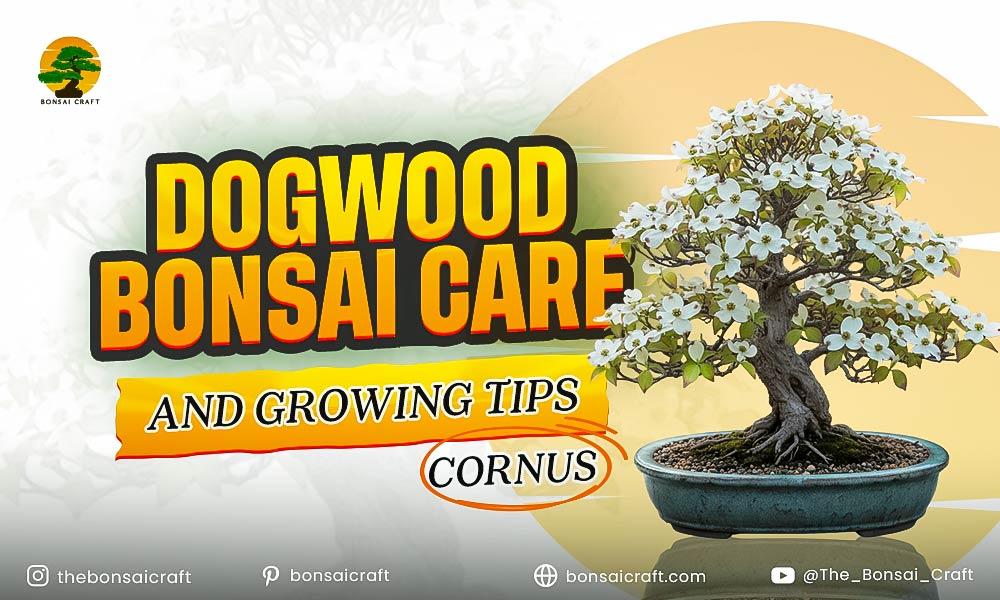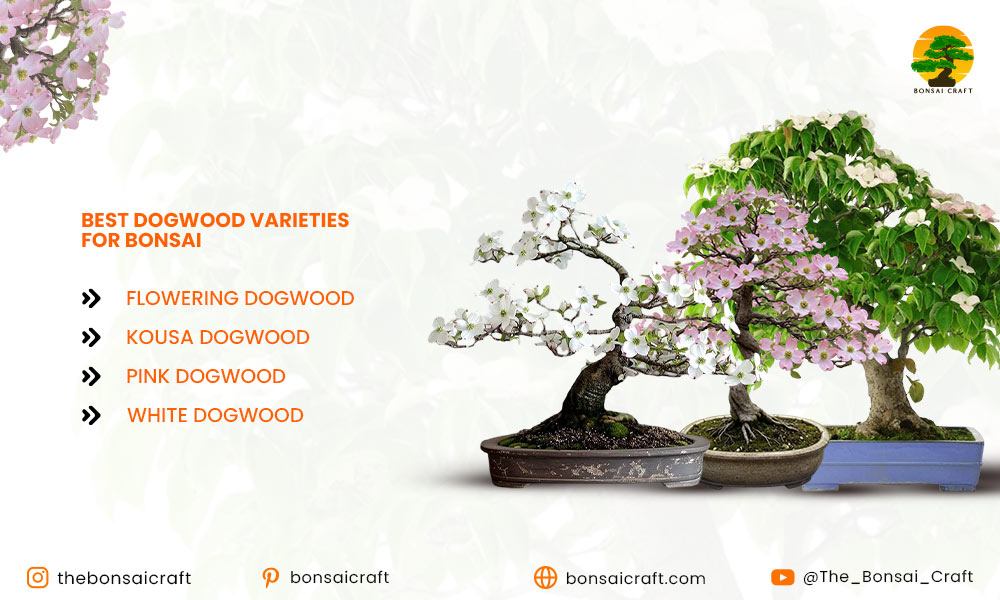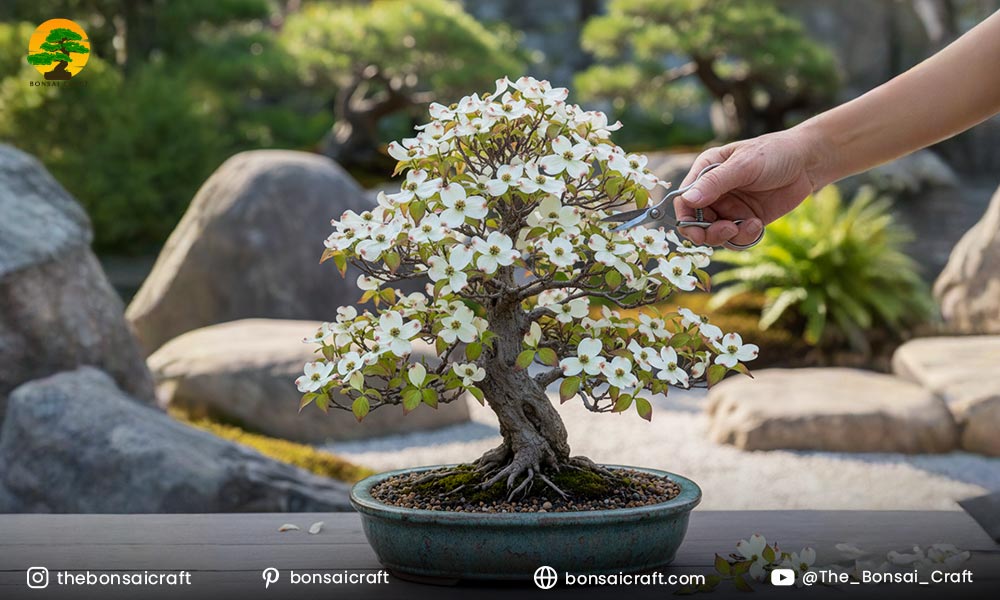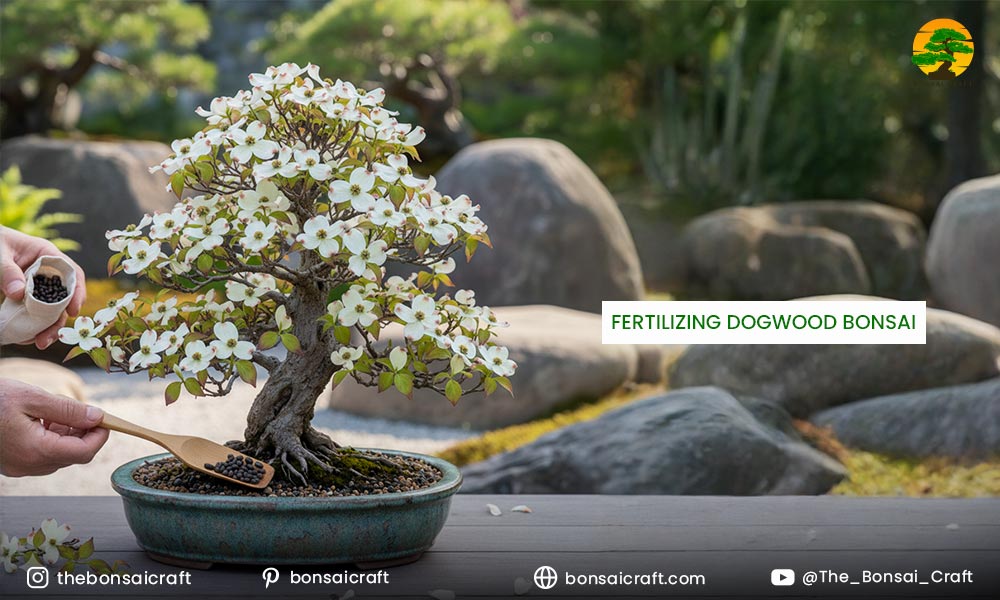
A dogwood bonsai is one of the most breathtaking bonsai trees you can grow. Known for its elegant structure and seasonal beauty, the flowering dogwood bonsai produces clusters of white, pink, or red blossoms in spring, followed by attractive foliage and berries in autumn. Unlike many bonsai species, dogwood bonsai trees (Cornus) are admired for their ornamental appeal throughout the year.
With over a decade of bonsai-growing experience, I’ve worked with different bonsai dogwood varieties, including Kousa dogwood bonsai, pink dogwood bonsai, and white dogwood bonsai. Each variety requires attention to detail, from soil selection to pruning and winter protection. In this guide, you’ll learn everything you need to know about dogwood bonsai care, including watering, pruning, repotting, and seasonal adjustments, along with professional tips for keeping your bonsai dogwood tree thriving indoors or outdoors.
What is a Dogwood Bonsai?
A dogwood bonsai is a miniaturized version of the dogwood tree bonsai (Cornus), kept in a container and sculpted to resemble a tree. The dogwood tree is a top choice for bonsai lovers for its spring flowers and colorful fall changes, beauty, and complexity.

Best Dogwood Varieties for Bonsai
Different dogwood bonsai varieties offer unique appearances:
- Flowering Dogwood Bonsai (Cornus florida): Iconic U.S. native with showy white or pink flowers.
- Kousa Dogwood Bonsai (Cornus kousa): Popular in bonsai because of smaller leaves and flowers, great for refinement.
- Pink Dogwood Bonsai: Produces soft pink blossoms in spring.
- White Dogwood Bonsai: Classic variety with pure white bracts.
Each bonsai dogwood tree requires similar care principles but may differ slightly in flower size, leaf color, and winter hardiness.
How to Care for a Dogwood Bonsai?
When caring for a dogwood bonsai tree, it should be placed in full sun or partial shade, watered often to keep the soil moist, the blooms should be pruned after, and it should be repotted every couple of years. They also need to be mulched or placed in a cold frame in the winter but this depends on the climate.
Detailed Care Guide
- Light Requirements:
- Your bonsai dogwood tree should get placed in direct sunlight for 4-6 hours every day.
- In order to prevent the scorching of the leaves, afternoon shade is necessary in higher climates.
- Watering:
- Dogwood bonsai care means the soil of the tree cannot be waterlogged or dried out.
- In the summer, trees should be watered every day or when the soil is dry.
- Soil:
- Using a well-draining bonsai soil Mix which consists of akadama, pumice, and lava rock.
- Slightly acidic soil improves leaf and flower growth.
- Temperature & Placement:
- Outdoors is ideal; indoors should be temporary.
- Kept protected from bone-chilling frost in the winter is best placed in a cold-frame greenhouse, or an unheated garage..

Dogwood Bonsai Pruning Techniques
Prune a dogwood bonsai right after flowering in late spring. Trim back long shoots, remove crossing branches, and shape the canopy to maintain proportion. Avoid heavy pruning in winter since buds form on old wood.
Detailed Explanation:
- Structural Pruning: Start by removing thick, unwanted branches that ruin the flow.
- Maintenance Pruning: Pinch back new shoots during summer for refined growth.
- Flower Bud Management: Since flowers form on older wood, avoid pruning heavily after summer.
- Wiring: Use aluminum or copper wire carefully during the dormant season to shape branches, but remove it within 6 months to avoid scarring.
Repotting a Dogwood Bonsai
Repot a dogwood bonsai tree every 2–3 years in early spring before new growth starts. Use well-draining bonsai soil and trim about one-third of the root system.
Steps:
- Gently remove the tree from the pot.
- Trim thick or circling roots.
- Refresh with nutrient-rich bonsai soil.
- Water thoroughly after repotting.
- Place in semi-shade for 2–3 weeks to reduce transplant stress.
Dogwood Bonsai Winter Care
Dogwood bonsai winter care is crucial for survival in colder climates.
- Cold Hardiness: Most dogwood bonsai trees tolerate cold but require protection from freezing winds.
- Storage Options: Cold frames, unheated sheds, or burying pots in mulch.
- Avoid Indoor Overwintering: Unless temperatures are extreme, avoid keeping indoors for the entire winter—it may interrupt dormancy.
Dogwood Bonsai Styles
The bonsai dogwood tree adapts to several styles:
- Informal Upright (Moyogi): Natural curves with balanced canopy.
- Multi-Trunk Style: Works beautifully with flowering dogwood bonsai for a forest feel.
- Cascade (Kengai): Rare but possible with flexible young trees.
- Literati (Bunjingi): Long slender trunk with minimal branches, emphasizing elegance.
These styles highlight seasonal changes especially the blossoms and autumn foliage.
Common Pests and Problems in Dogwood Bonsai
- Powdery Mildew: Keep leaves dry, improve airflow.
- Leaf Spot Disease: Prune affected leaves and use a fungicide.
- Aphids & Scale Insects: Use neem oil or insecticidal soap.
- Root Rot: Caused by poor drainage; fix with repotting and soil adjustment.

Fertilizing Dogwood Bonsai
- Use balanced bonsai fertilizer (10-10-10) during the growing season.
- Switch to low-nitrogen fertilizer before flowering to enhance blooms.
- Apply every 2 weeks from spring to autumn.
Seasonal Care for Dogwood Bonsai
- Spring: Gently dose fertilizer and trim after blossoms.
- Summer: Augment watering and add partial sunlight.
- Autumn: Relish the beauty of the leaves and less feeding.
- Winter: Shield against frost and root concerns. No feeding and allow hibernation.
Conclusion
Caring for a bonsai dogwood tree may seem like a simple task but in reality, the process requires one to build devotion as the tree beautifully reconstructs the entire landscape. Pruning and properly watering this tree in winter will allow it to blossom during spring and preserve its leaves during the chilly months. Bonsai dogwoods are a sight to behold throughout the year, especially when no effort has been spared, and a masterpiece has been cultivated for it to withstand the years.
Expert Tip: If you’re a beginner, start with a Kousa dogwood bonsai—its smaller leaves and hardiness make training easier than other varieties.
FAQs on Dogwood Bonsai Care
Can you bonsai a dogwood tree?
Absolutely! Dogwood trees can be bonsai-ed and so can flowering and Kousa ones. Kousa ones are especially suited because they maintain the flower pattern and their colors are seasonally vibrant in addition to responding well to pruning, wiring, and container growth.
How often should I water a dogwood bonsai?
As with all trees, a dogwood bonsai should be watered when the soil on top is a little dry. Flowers are also more likely to adorn the tree during June and July.
When should I repot my dogwood bonsai?
Before the new bud break, repot your bonsai dogwood tree from its pot every 2-3 years, doing so in early spring. This helps save energy while ensuring the tree grows new roots.
Do dogwood bonsai trees flower indoors?
Indoors, dogwood bonsai may bloom in smaller quantities due to insufficient light and seasonal changes. For optimal blooming, it is best to keep the flowering dogwood bonsai outdoors, where it can absorb the natural light and breathe the changes in temperature.
What is the best fertilizer for dogwood bonsai?
For dogwood bonsai care, the best fertilizer is a balanced 10-10-10 formula, available in either powdered or granular form. Apply it every two weeks for the duration of spring and summer. Before blooming starts, switch to a low-nitrogen fertilizer to promote flowering.
